|

by Ron Schmidt
2006
from
TheLivingMoon Website
Contents
-
Part 1 - Lunar Strip
Mine Operation
-
Part 2
- Mining Connections
-
Part 3
- More Afoot in Antarctica
-
Part 4
- The Walt Disney-Werner Von Braun
Collaboration
Part 1
Lunar Strip Mine Operation
"Those who Know Don't Speak,
Those Who Speak Don't Know".
Unknown Vril Society
member
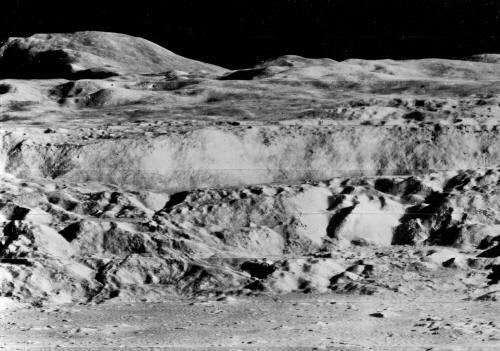
Copernicus 1-2 from
Lunar Orbiter 2 H-162 (1965-1966)
The above photo is part of a set under discussion at Above Top
Secret, provided by John Lear.
John Lear's Moon Pictures on ATS
The direction and purpose of this
article is to show the events leading up to the discovery of the
Mining Operation actively in progress on
the
Moon.
Though Pegasus Research Consortium
has been researching these matters, this collection was assembled on
the basis of photographic evidence presented by
John Lear at Above Top Secret.
We will include information on,
These are the key points, but other
issues will be addressed as well, mainly the repercussions of this.
The information has been pieced together
from a variety of sources and will continue to grow as more people
add information, evidence and opinions. We offer this information
freely in an effort to show what is and has been happening, and
leave the reader to form his/her/its own conclusions.
This page covers "When did it start"; "Where are they doing it
from"; "Who is doing it" and a beginning hint of "How are they doing
it"
We had our
Chance and Threw it Away!
In the 50 years or so building up
to the Second World War, the world was teeming with bright
scientists coming up with an amazingly diverse amount of discoveries
and projects.
In fact most major discoveries of our
century originated from that time period, from Penicillin to DNA,
from A-bombs to Rockets and even delving into controversial ideas
and laying the ground work for such concepts as anti-gravity, zero
point energy and electric space propulsion.
If ever there was a pivotal time in Human History, this was it.
We had all the thinkers, the ideas and
the models that could have directed society along the path leading
to free energy and interstellar space travel. Societies abounded who
tried to do this, including the Rosicrucians who created the USA
through Ben Franklin, George Washington and others. The intent was
to create a nation of free thinkers, were citizens were free from
government oppression. We could have had it made.
But the human race chose war, they turned the new science into
killing machines and worked to suppress any knowledge and concepts
that would foster such ideas as "free energy" Scientists and
innovative engineers died or disappeared, (the ones not working for
the governments), or they were ridiculed and ruined.
Labs and projects destroyed, documents
vanish... till all that is left of the ideas is carried by
"crackpots and lunatics". We threw it all away.
The list below is just some of the really important discoveries
beginning and ending, appropriately, with
Nikola Tesla, a man who gave us the ignition coil for
our cars and alternating current to power our lives.
Only now are his ideas resurfacing.
Perhaps we are approaching another pivotal point. Perhaps that is
what is meant for the change due in 2012. Maybe we will have another
shot.
Let's hope we don't miss this one.
See
list here...
In The Beginning...
From the listing above it is clear to see that science was off to a
running start on improving the human condition in all fields.
A scientist could follow his ideas
without fear of government intervention, though then as now the free
thinkers were subjected to ridicule by their piers. But in thousands
of labs around the world, the ideas, the inventions and the patents
emerged.
Just check the Swiss Patent Library for
the time period and you will see the amazing works that were
contemplated and granted patents for.
So what happened? The Nazi's
The second World War has been
well documented and there is no need to go into main stream details.
However there is an overwhelming
collection of evidence showing research and activity on a different
path. This path involved research into Ancient Gods and the origins
of man, much as we are doing today, though the purpose was sinister
and the intent was to use that knowledge for control.
At the same time
the German scientist
began a huge campaign to research all kinds of alternate technology.
We all know the rocket programs and what
happened to the scientists after the war... but there were other
scientists involved in other black projects that did not get the
media attention of the rocket scientists...
The Nazi Scientists of America
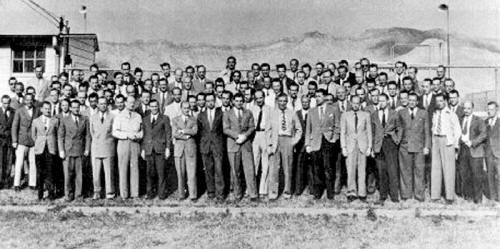
After the war, 118
German rocket scientists worked together at Fort Bliss, Texas.
(U.S. ARMY AVIATION AND MISSILE COMMAND)
Excerpt...
The front page of The New York Times
on November 17, 1945, bore a curiously vague headline: “88
German Scientists Reach Here, Reputedly With Top War Secrets.”
The scientists had arrived on a
converted ocean liner the day before - 60 years ago today - and
been immediately “whisked away” aboard a fleet of buses.
“Unusual precautions were taken
to keep the arrival secret, and reporters who went on board
the ship and found the eighty eight men waiting to land …
were warned away,” the Times reported.
The paper speculated that the
group's arrival was the result of a program announced weeks
earlier by the War Department to bring German scientists to
America, and in spite of the secrecy, the Times guessed right.
Men who just seven months earlier
had been at war with the United States were being ushered onto
our shores by the government. The purpose: to jump start
American high tech industry.
And they weren't the first. The ink was barely dry on the
surrender documents before a German missile expert was working
12 hour days under military guard in Washington, D.C.
He was
followed in the coming decades by as many as 1,600 experts in
biological and chemical warfare, submarines, rockets, and
aviation. These men and women were in essence spoils of war,
taken by the victor to benefit from the vanquished foes history
of scientific achievement.
The majority of Nobel prizes up to
1939 had gone to Germans, and Hitler had been quick to exploit
his talented countrymen.
Excerpt...
Intelligence and government
officials faced a delicate moral quandary in 1945 - whether it
was worth it to give American homes to men who had invented
weapons to kill American soldiers, men who in some cases
subscribed to beliefs that hundreds of thousands Americans had
died to eradicate.
In the end they decided it was, if
these men could help the United States defeat the Soviets.
Christine Gibson is a
former editor at American Heritage magazine.
And so it begins...
Source:
American Heritage Events Posted Wednesday
November 16, 2005 07:00 AM EST
The Nazi Era
1930 - 1945
There is no way to discuss this dark event in human history without
stirring memories of horrors and atrocities, but we would like to
put that aside for now and look at the Era in regards to the
advanced technology that was being researched, explored, and tested
at the time.
Had we not stopped them when we did, who
knows were it would have led..
There are many conspiracy sites and UFO research websites that have
dealt with this topic over the years, and as new evidence comes out
due to the release of 50 plus year old documents that are being
declassified, the evidence is to big to ignore. Since so much work
has been done already, we will simply pick some better examples to
direct you too for more research.
It is not necessary for the purpose of
this paper to cover all the details, merely show the sequence of
events.
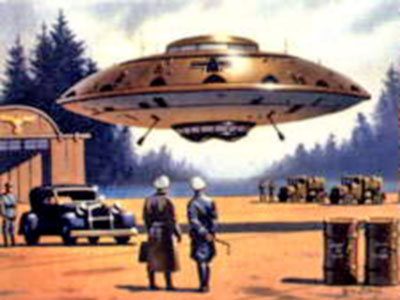
But before we continue, there is a one
hour long video that is so far the best summary of the evidence and
it is put together into an amazing and informative presentation.
Take the time to watch this, or review
it now in context with this article "The
Secrets of the Third Reich".
This is a must see for anyone interested in the UFO phenomena as
well as those looking into the Sumerian Anunnaki and Nibiru aspect
of our past.
There is much discussion in the film about the alien contact that
certain factors of the Regime claimed, particularly pertaining to
the Alderbaran system. One of the interesting points in the film is
the connection to Alderbaran and the girls in the Parade that look
like "Princess Leia" in Star Wars...
The "Black Sun Organization" is
featured in the film series as a shadowy criminal syndicate that
permeates the entire galactic underworld.
The film covers the events leading up to Hitler's rise to power. The
esoteric secret societies were all involved at the beginning,
thinking this was the coming of the "New Golden Age".
The Masons,
the Knights Templar, the Rosicrucians and many others, but soon
withdrew when they saw the direction it was going in. At the end
only the Thule-Gesellschaft (Thule Society) Hitler and other Nazi
officials were members of this society.
The Vril Society and the SS
Black Sun Organization were off shoots of the Thule Society...
The film then goes into the research into alternate energy and
flying disc designs. There are many live interviews with witnesses.
The British new about these secret projects as early as 1941. There
are many descriptions and reports by allied pilots of "foo fighters"
that were buzzing around their airplanes.
The next section is about the design, building and testing these
flying disks...
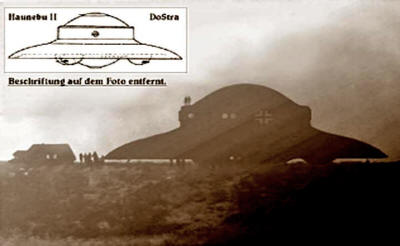
For those who can read German
here is a fantastic site with
pictures of all sorts of projects.
The Haunebu and Vril Plans
Due to 50 years having
passed, these documents have been declassified recently. They show
the order form and plans for
the Nazi saucers.
The Antarctica
Connection
1924 -1947
Shortly before the end of the war, rumors abounded of three Nazi
U-Boats that fled to a secret base in Antarctica, taking with them
as much of the disassembled Saucer technology and supposedly the
most important flying saucer the larger
Haunebu III.
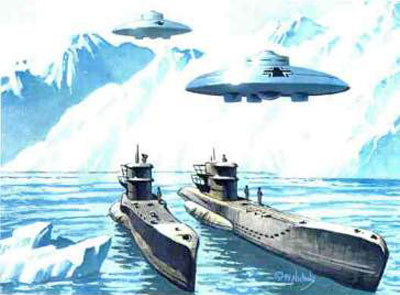
There are many such stories and one must
sort through them, however there is one tangible clue that is
documented. The Allied forces mounted a large expedition to the
Antarctic in 1947 under the leadership of
Admiral Byrd.
Excerpt:
On May 19, 1943 the Allied Forces
suspected something unusual was going on in a secret German
Antarctica base because of the great "movement" of submarines in
direction to the South Atlantic.
Below are all the links from beta.profusion.com. It's overkill,
sure... but perhaps someone will gather all the photos from
these links. It's amazing: through all the Vostok anomaly,
Schwabenland was never suggested. It's amazing this topic was
lost to "UFO mystery" websites. Perhaps someone wrote a book
about this.
I think the public should really
study this, and admit what the Germans were shown. It appears
that Hitler was not a part of this secret German group that went
to Antarctica after WWII.
Source
Editors Note:
Unfortunately it appears some of the links at the above site have
been removed. We will try to track them down.
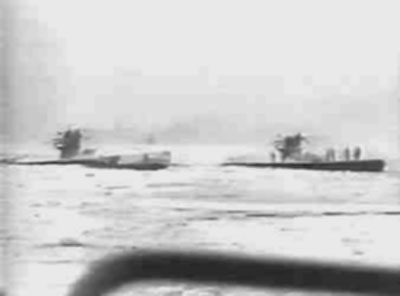
U-boats of Antarctica
Background
Information
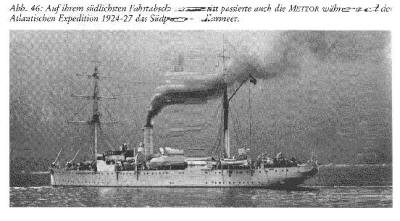
First German
Antarctic Expedition 1924-27
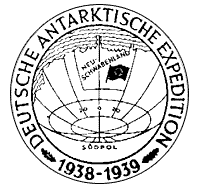
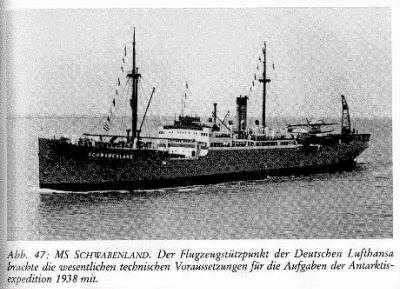
Second German Antarctic Expedition 1938-39
SOURCE:
Nazistützpunkt in der Antarktis
Editors Note: This
website report is in German, but has a very precise time line with
details and important names of those involved. A translation is
necessary and I will attempt to post one soon. However this and many
other documents show major activity by the Germans in Antarctica
before and during the War.
Britain's Secret War
in Antarctica
1938 - 1945
Admiral Byrd Expedition...
Antarctica 1947
Operation Highjump
Britain's Secret War
Introduction
In 1938, Nazi Germany sent an expedition to Antarctica with a
mission to investigate sites for a possible base and to make formal
claims in the name of the Third Reich.
To prepare them for their mission, they
invited the great polar explorer Richard E. Byrd to lecture them on
what to expect. The following year, a month after hostilities had
commenced in Europe, the Germans returned to Neuschwabenland to
finish what had been started, with many suggesting that a base was
being constructed.
Nine years later, Richard E. Byrd, who by now had become an Admiral
in the United States Navy, was sent to Antarctica with the largest
task force ever assembled for a polar mission. In Admiral Byrd's own
words, the mission (code named Highjump) was "primarily of a
military nature".
Many claim that the task force was sent
to eradicate a secret Nazi base in Queen Maud Land, which the Nazis
had renamed Neuschwabenland and which had never been explored as
profoundly as the rest of the Antarctic. But, and the big but is,
the fact that Admiral Byrd spoke of "flying objects that could fly
from pole to pole at incredible speeds" and with well documented
German activity before, during and in the immediate aftermath of
World War II, one can't help but wonder whether there is some truth
in the Nazi Antarctica myth.
Even so, could
Operation Highjump and
Byrd's quotes have overshadowed the truth about British excursions
in Antarctica by way of misinformation, bringing attention to his
mission and, by doing so, making sure that history only remembered
one mysterious Antarctic mission?
When the Antarctica mystery is mentioned, Britain is never given
more than a footnote.
That fact is surprising in itself, especially
as British forces were active in Antarctica throughout the war and
quite possibly took the initiative in dealing with the Antarctic
Nazi threat a whole 12 months before Operation Highjump was
initiated.
Britain's activities on Antarctica, though less documented and more
clandestine, are just as intriguing as the supposed much vaunted
Operation Highjump. Unfortunately for Britain, though victorious in
the War, it was bankrupted and humiliated by the two new
superpowers.
But Britain was in a position to regain
some pride and surreptitiously upset its supposed allies with the
final, decisive battle against the surviving Nazis:
-
a battle that
would never be recorded in the history books
-
a battle that would
make its claims on the continent more legitimate
-
most importantly, a battle that
ended the war that it had been compelled to wage
Key Excerpts
from the Above Article
Excerpt One
What does help
substantiate their story is the little known fact (which Pravda
reported on 16 January 2003) that, in 1983, Special Services
seized a confidential letter that Captain Scheffer wrote to
Captain Bernhard, and in the letter Scheffer pleads to Bernhard
not to publish his memoirs in too profound a detail and, in
fact, states his intent for the world not to know the truth:
"We all made an oath to keep the
secret; we did nothing wrong: we just obeyed orders and
fought for our loved Germany and its survival.
Please think
again; isn't it better to picture everything as a fable?
What results do you plan to achieve with your revelations?
Think about it, please."
Excerpt Two
The missing U-boats were
part of the Antarctic jigsaw puzzle that Britain had been
putting together since the Nazis first sent Admiral Ritscher on
his Thule sponsored polar mission.
And with Britain's Intelligence
network - the SOE (Special Operations Executive) and the SIS
(Secret Intelligence Service) providing virtually all the
information to the Allied Forces via the Enigma machine and its
immense European spy network during the War, the picture was
appearing slowly.
One prime example of Britain's Intelligence excelling was in how
much Britain knew about the Nazi's secret atomic weapons
programs which, in turn, helped the RAF bomb the Nazi's secret
research station at Peenemünde in the Baltic Sea.
The Germans were at a loss to how
the British had even heard about it, let alone been able to bomb
it.
Excerpt Three
"Antarctica was a secret but
rumors persisted, and only for the most dedicated was it a
haven. Most of those with any intimate knowledge of
Neuschwabenland did not see the end of the war, and of those
who did, the majority were executed, committed suicide or
were sent to the Russian gulags...
Only those captured by the
British forces fared better, but after interrogation were
forbidden to mention their wartime exploits again. The
threat of having damaging wartime links brought up kept the
Germans silent and helped the Allies suppress the truth."
Excerpt Four
Whilst researching Third
Reich mysteries, I encountered an East German source who had
served in the Kriegsmarine and has first-hand accounts about
Neuschwabenland.
He claimed:
"Neuschwabenland, after Europe,
was in ruins and Norway, completely in German hands, became
the only viable base of operations. When it was decided that
for the German nation surrender was best, those who could,
left, and took their chances in the U-boat convoys.
"Antarctica was a secret but rumors persisted, and only for
the most dedicated was it a haven. Most of those with any
intimate knowledge of Neuschwabenland did not see the end of
the war, and of those who did, the majority were executed,
committed suicide or were sent to the Russian gulags...
Only those captured by the
British forces fared better, but after interrogation were
forbidden to mention their wartime exploits again. The
threat of having damaging wartime links brought up kept the
Germans silent and helped the Allies suppress the truth."
Excerpt Five
From 1941 until the start
of the British/Swedish/Norwegian Expedition of 1949 - 52,
Britain sent at least 12 official missions to Antarctica, half
of them between the end of the war and the beginning of
Operation Highjump, led by Admiral Byrd, starting in December
1946.
Even more intriguingly, Britain sent
no missions from the commencement of Highjump until 1948, during
which time the US had Antarctica all to itself. Britain
nonetheless was more active in Antarctica during the 1940s than
any other nation, yet the only Antarctic mission mentioned in
depth by historians is Admiral Byrd's.
His mission still overshadows every
other mission and is the main focus of attention for many
conspiracy theorists. Britain's exertions were and still are
totally overlooked; and with Admiral Byrd spreading
misinformation, the true conspiracy concerning Antarctica as a
Nazi haven was forgotten.
Excerpt Six
In the UK, British
Intelligence unearthed more of Norway's secrets but suppressed
them; Antarctica was no exception.
When the Norwegian Government
returned to a liberated Norway, Antarctica soon returned to
their consciousness, though the Norwegians would have to wait
several years to go back there, lest the rumors of a Nazi base
were true.
On the other hand, Britain decided it had collated enough
knowledge about Antarctica to initiate an intense investigation,
one that had to dispel all fears and hide all evidence, for it
could not tolerate any more technology or personnel being
acquired by the wrong hands, namely, the USSR and the USA.
Britain had helped liberate Norway and, as 1945 was drawing to a
close, was in the process of "liberating" Queen Maud Land (the
new atlas of the post-war world no longer recognized
Neuschwabenland). However, the mysterious wartime expeditions
conducted by all the combatant countries, especially Germany,
were not entered into the World War II history books.
A travesty of history had occurred.
Excerpt Seven
As discussed in part one, the Nazi "Shangri-La" did exist.
Of unknown size, it was set up
during the 1938-39 Deutsche Antarktische Expedition. The
existence of a Nazi Antarctic base hidden in vast caverns was
considered feasible enough for the British to set up bases in
many parts of Antarctica during the war in response to the
threat.
And whilst the officially recorded
British expeditions mainly concentrated around the Antarctic
Peninsula, those not recorded were those that concentrated on
investigating Queen Maud Land, so named by Norwegian whalers
prior to 1939 in honor of Queen Maud of Norway (1869 - 1938),
consort of King Haakon VII and formerly Princess Maud of the
United Kingdom, a granddaughter of Queen Victoria.
Excerpt Eight
Britain's arrogance in
committing troops to Antarctica, independent of the United
States, and in celebrating the feat with the release in February
1946 of a provocative stamp set, would inevitably lead to
Britain's claims on Antarctica being contested, even though the
stamps commemorated Britain's final fight with Nazism rather
than being a statement of its Antarctic claims.
And even though Britain expressed
outrage publicly when Highjump was launched, it was just a
pretense: privately, Britain knew that the USA's newfound
superpower status meant that it would not permit Antarctica to
be utilized by other nations for financial gain.
Source
The United
States Enters the Picture
1945-1958
The USA, distracted by the war against Japan and the brewing Cold
War, had been caught short by Britain's Antarctic exertions and
humbled by its aggressive stance.
So the Americans soon adopted a policy,
dreamt up during the war, that would destroy Britain's imperial
aspirations, hinder every attempt by Britain to exert any influence
around the world and make the country an "ally" in name only.
However, as early as 1942, Britain and British identity were
suffering as a result of the United States' globalization agenda.
It must be remembered that Britain was
denied its own atomic bomb, despite the fact that the bomb could
have not been created without British expertise. Furthermore, the
British people faced worse rationing than any other Western nation,
lasting direfully until the 1950s, and Britain was also pressured
into giving full independence or self government to most of the
territories in its Empire.
So, whilst Britain went into World War II a superpower, by the end
of the war and by the actions of American foreign policy, especially
Operation Highjump, it had been put firmly in its place. The United
States became the only country that could successfully influence
Britain, as the 1956 Suez crisis proved.
Even now, 60 years after the end of
World War II, British blood is still being shed on behalf of US
foreign policy.
Excerpt One
Britain halted its
Antarctic flights and operations for two years, giving the
United States a free hand in Antarctica with the commencement of
Operation Highjump.
With the Nazi haven destroyed, there
was little need for the British to return: the Americans would
not discover anything that had not already been discovered. Or
would they?
In the two years they had to discover as much about Antarctica
as possible, the Americans found dry areas and warm water lakes
that provoked immense media interest, but Operation Highjump,
which they'd planned to last for six months, ended after just
eight weeks.
They received a hostile reaction
from other nations, but it was only after the mission's return
that the rumors and theories began to abound and the enigma
surrounding Highjump really began.
Excerpt Two
In the years prior to the
June 1961 ratification, the USA, UK and USSR had all used
Antarctica for military purposes and all three nations were
rumored to have tested nuclear bombs on the continent.
On 27 and 30 August and 6 September
1958, at least three such bombs were detonated in Antarctica,
allegedly by the Americans. Rumor has it that they were set off
in the area of Queen Maud Land and were triggered 300 meters
above the target, with the initial aim being to "recover" frozen
areas.
The locations of other bomb
detonation sites have been firmly suppressed, but it is believed
that the areas reconnoitered by the Germans in 1939 and 1940
were targeted.
With the Germans and Americans officially claiming to have found
warm water lakes on their expeditions, it was only a matter of
time before more were discovered. One such lake, discovered by
the Russians, is
Lake Vostok, which is 4,000 meters below the
surface and curiously is located under the Russian base camp of Vostok.
News of the discovery was not
released to the world until 1989, so had the Soviets found the
subterranean lake years earlier and was this their main reason
for refusing to leave its base?
The lake has still not been
investigated, mainly out of fear of what could be unleashed and
to avoid contamination of the lake, although a huge magnetic
anomaly has been identified.
Excerpt Three
Subterranean lakes with
signs of life, geothermally warmed lakes in dry valleys in a
supposed frozen wasteland, viruses that threaten mankind,
mysterious holes in the atmosphere allied with suppressed
military ventures may seem the work of fiction, and yet they are
all fact!
Antarctica is a truly mysterious
place, and that is why it is inconceivable that the Nazis would
claim an area and leave it unoccupied and undefended...
...Whether the British mission did destroy the Nazi base, with
any remaining Nazis finally being expunged by the atomic force
of the wartime allies, is not the question that needs asking.
What is, though, is just how much of
Antarctica's past, present and, indeed, its future has been, is
being and will be suppressed?
SOURCE
Operation Highjump
November 1946
THE UNITED STATES NAVY
ANTARCTIC DEVELOPMENTS PROJECT 1946-1947
RADM Richard E. Byrd (USN Ret.) - Officer in Charge TASK FORCE 68
RADM Richard H. Cruzen, USN, Commander TASK FORCE 68
Source
This website proves through postage stamps and associated true
history that the expedition occurred.
There are several pages of detailed
information and pictures of the ships, though this article
constitutes the "official" version, the size and scope of the
operation and from Admiral Byrd's own words, the purpose of the
mission is definitely not exploration, but military.
List of the ships involved in the expedition.
|
EAST GROUP (Task
Group 68.3)
Captain George J. Dufek, USN
USS PINE ISLAND:
Seaplane Tender
USS BROWNSON : Destroyer
USS CANISTEO: Tanker |
WEST GROUP (Task
Group 68.2)
Captain Charles A. Bond, USN
USS CURRITUCK :
Seaplane Tender
USS HENDERSON : Destroyer
USS CACAPON : Tanker |
|
CENTRAL GROUP
(Task Group 68.1)
USS MOUNT OLYMPUS:
Communications
USS YANCEY: Supply
USS MERRICK : Supply
USS SENNET : Submarine
USS BURTON ISLAND: Icebreaker
USCGC NORTHWIND : Icebreaker |
CARRIER GROUP
(Task Group 68.4)
USS PHILIPPINE SEA:
Aircraft Carrier
BASE GROUP (Task
Group 68.5)
CDR Clifford M.
Campbell, USN, Commander TG68.5, Little America
IV |
|
Meanwhile, as sadness permeated the American naval bases, (from
decommissioning of ships, ed.) Admiral D.C. Ramsey, chief of
naval operations, was in Washington signing his name to an
astounding set of orders addressed to commanders in chief of the
Atlantic and Pacific Fleets.
These orders would establish the
Antarctic Developments Project which would be carried out during
the forthcoming Antarctic summer (December 1946 - March 1947).
Chief of naval operations, Chester W.
Nimitz, code named the project
Operation Highjump.
Instructions were for twelve ships and
several thousand men to make their way to the Antarctic rim to,
-
train personnel and test
material in the frigid zones
-
consolidate and extend American
sovereignty over the largest practical area of the Antarctic
continent
-
determine the feasibility of
establishing and maintaining bases in the Antarctic and to
investigate possible base sites
-
develop techniques for
establishing and maintaining air bases on the ice, with
particular attention to the later applicability of such
techniques to operations in interior Greenland, where, it
was claimed, physical and climatic conditions resembled
those in Antarctica
-
amplify existing knowledge of
hydrographic, geographic, geological, meteorological and
electromagnetic conditions in the area.
Following is a few selected excerpts...
visit the site to read the lengthy but informative report...
-
Although not specifically stated
in the August 26, 1946 orders, a central objective of the
project was the aerial mapping of as much of Antarctica as
possible, particularly the coastline...
-
Also in January 1947, famous
aviator Eddie Rickenbacker was pushing for American
exploration in Antarctica, including the use of atomic bombs
for mineral research.
-
November headlines in the New
York Times declared a six nation race to Antarctica "set off
by reports of uranium deposits". The article went on to
charge that the British was leading the race by sending a
"secret expedition" to occupy Byrd's 1939-41 "East Base" at
Marguerite Bay on the Antarctic peninsula. Actually, the
British had been active in Antarctica for a number of years.
-
The formal American position on
the polar regions had always been that they should be open
to exploration and research by all concerned but in the wake
of Admiral Byrd's formal announcement of OPERATION HIGHJUMP
on November 12, 1946, Latin American governments became
nervous and suspicious of the notorious American Yankee.
OPERATION HIGHJUMP was seen as a huge threat to future Latin
American claims. After all, thirteen ships with 4,700 men
seemed to confirm the notion that the United States had a
plan of their own to seize huge chunks of the continent.
The official press release by
Byrd seemed to confirm their anxiety as OPERATION HIGHJUMP
was justified as an "extension" of the United States Navy's
"policy of developing the ability of naval forces to operate
under any and all climatic conditions".
A publicly stated objective was
to "consolidate and develop the results of the US ANTARCTIC
SERVICE EXPEDITION 1939-41".
As it turns out, the Latin
suspicions were correct. Initial approval of OPERATION HIGHJUMP was apparently reached at a meeting of the
"Committee of Three" (Secretary of State, Secretary of War
and Secretary of the Navy) on August 7, 1946.
-
Admiral Marc Mitscher, commander
in chief of the Atlantic Fleet, was even more daring in his
"Instructions for OPERATION HIGHJUMP " issued on October 15.
"Objectives" included "Consolidating and extending United
States sovereignty over the largest practicable area of the
Antarctic continent".
Perhaps the Departments of State
and Navy had wished for major territorial claims, but the
fact of the matter is that no formal claims were made by the
men of OPERATION HIGHJUMP. It was not launched in a scramble
for Antarctica's natural resources nor was it launched for
the chief purpose of territorial expansion.
According to news releases of
Admiral Byrd's November 12 press conference announcing
OPERATION HIGHJUMP,
-
"The Navy strongly
discounted reports that the voyage will be primarily
a lap in the race for uranium. 'When this expedition
was first talked about, uranium wasn't even
mentioned. The statement that this is a uranium race
for atomic energy is not correct', Admiral Byrd was
quoted as saying.
However, the basic objectives
were not diplomatic, scientific or economic - they were
military. OPERATION HIGHJUMP was, and to this day still is,
the largest Antarctic expedition ever organized.
-
Admiral Ramsey's preliminary
orders of August 26, 1946, stated that "The Chief of Naval
Operations only will deal with other governmental agencies"
pertaining to OPERATION HIGHJUMP.
Thus, it seemed there would be
little room for civilian scientists and observers.
In the film "The
Secrets of the Third Reich" in an interview, Virgil
Armstrong, a retired CIA Agent talks about the Byrd expedition
and states,
"The later reports indicated that
Admiral Byrd was given 8 months and unlimited funding to go in
and pull this thing successfully off! But we also know that
within 8 weeks he was totally defeated.
Now the supposition at that point
was that there was an advanced civilization and technology most
probably alien that were with the Third Reich and the SS who was
in Antarctica and that those greatly developed technologies were
used to defeat Admiral Byrd"
In a television interview after the
expedition Admiral Byrd commented,
"...that in the event of another
war, the hard facts were that we would have to reckon with an
attack from aircraft that could fly from pole to pole."
Mt Rainier Incident
June 1947
The beginning of the modern UFO era is often traced back to June
24, 1947, when businessman
Kenneth Arnold sighted "a formation
of very bright objects" while flying over the Cascade mountains
of Washington State.
He said he sighted nine saucer like
aircraft flying in formation at 3. p.m. yesterday, extremely
bright - as if they were nickel plated - and flying at an
immense rate of speed. He estimated they were at an altitude
between 9,500 and 10,000 feet and clocked them from Mt. Rainier
to Mt. Adams, arriving at the amazing speed of about 1200 miles
an hour.
"It seemed impossible," he said,
"but there it is - I must believe my eyes."
Source
Roswell Incident
July 1947
Again
the Roswell Incident has been covered continuously for the
50 plus years. The only significant point to our paper right now
is the time of the event... A standard report can be read here
at the Roswell Museum on the off chance someone has not yet
heard about it.
In the summer of 1947, there were a number of UFO sightings in
the United States. Sometime during the first week of July 1947,
something crashed near Roswell.
The above two famous incidents are
mentioned here because they happened within months of Admiral Byrd's
Antarctic expedition.
Since then
Flying Saucers have been
continuously spotted. Though I believe that our government has been
using Nazi technology and has been testing such craft, it is not our
intent to deny that aliens may or may not be involved.
Virgil
Armstrong, the retired CIA Agent said it best,
"...the supposition at that point
was that there was an advanced civilization and technology most
probably alien..."

The typical "Flying
Saucer" shape of the VRIL 1
NAZI UFO
Update
October 22, 2006
On MAY 2006 the
Russians released a 45 minute video about the NAZI
UFO enigma.
It contains much of the same saucer
images as the previous film above, but it has more photos and
briefly shows the drive unit glowing in operation. The film is in
Russian and we are awaiting a translation.
What is important in this film is that about 5 minutes into the film
the Admiral Byrd expedition to Antarctic is shown on live footage
from the time. The story is told by Russian Naval officers. There
are several great segments showing the U Boats in Antarctic waters.
the size of the fleet of Admiral Byrd and the planes on the deck of
the aircraft carrier.
Then they show film footage of the
battle!!! The planes being shot down... and the UFO's... One disk
flies swiftly between the camera and the smoke stack of the ship...
then they capture one slowly crossing the entire scene...
This is amazing footage and we anxiously await the translation...
Near the end of the film they briefly cover the underground
fresh water lake that sits below what is now Vostok Station in
Antarctica (Lake Vostok) The lake is about the size of
Lake Ontario.
Then there are images of HAARP and some views of a seismograph
taking readings. They show this in conjunction with describing a
wormhole that exists at both poles!!! Perhaps this is the hole
people have talked about at the poles?
Back to the coincidence that Stargate SG-1 found the Ancient's
Stargate in Antarctica with the involvement of the Russians. They
too covered a battle in Antarctica. There is just way to much
correlation to be merely coincidence in my opinion
Russian UFO Documentary May 2006
Secrets of the Third Reich II Nazi Bases in
Antarctica...
Adamski Type
Flying Saucer
1953
The only importance of this addition is the remarkable resemblance
of the
Adamski type UFO that was the "standard" of flying saucer
sightings all through the fifties and early sixties, to the Nazi
Haunebu II.
Though this reference has been made by
many, it is relevant to our search. It still remains the most
commonly posted image at UFO sites around the world and many people
describe this when they see one even today, especially in Japan.
(Ed. Note: Other types
of sightings are not relevant to this article and are discussed in
other files)
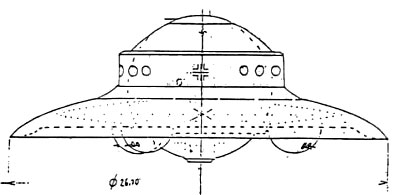
Nazi Design page for
the Haunebu II
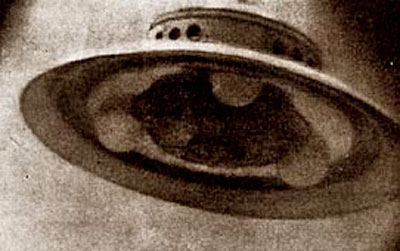
1953 - George Adamski's photograph of "Venusian" spacecraft
included in his book,
"Flying Saucers Have Landed."
Avro's Flying
Saucer - Is It a Joke or Will It Fly?
1950 -1959
In the fifties Canadian newspapers got wind of a secret military
project to build "flying saucers". This incident is well known in UFO
circles, yet the significance has been lost to the public today...
The whole incidence was connected to rumors that as early as 1954,
the anonymous European author of one version of the “V-7” or “Nazi
saucer” yarn wove the Avro saucer into his tale; he informed his
readers that the V-7's creator,
“Dr. Heinrich Richard Miethe,” was
at that time in Canada, reconstructing his wonderful craft under
the auspices of A. V. Roe (Avro).
Project
1947
The reports caused a lot of fuss at the
time... including reports of a huge area in western Canada that was
a secret joint Canada/US military base where they were building and
testing these "flying saucers"
In late 1954, the Canadian Government withdrew support from the
saucer project, because (in the words of Defense Production Minister
C. D. Howe),
“it did not seem sufficiently promising to be worth
going on with... it did not seem to have any useful purpose."
Manchester Guardian, 12/2/54
A few months later, the U.S. Air Force
picked up the tab, and immediately proceeded to shroud the project
in its habitual ridiculous secrecy (Toronto Globe and Mail,
8/23/55).
Four years have now passed since the Air Force took over,
and yet it appears that Dr. Miethe has still not succeeded in
rebuilding the marvelous craft that he developed in wartime Germany
in 1945.
News Flash: UPI item by Norman Cornish datelined Washington,
4/14/59:
"The United States will test fly its
first “flying saucer” this summer, a defense expert said
today..."
Reaction: Lehighton (Pa.) Leader
“The disclosure that the United
States has the flying saucer is tremendously significant news,”
exclaimed the Lehighton (Pa.) Leader.
“Beyond doubt we had had the flying
saucer for years - since the time people started
seeing them - but our government did not feel ready
to admit it... Some people couldn't help but notice it flying
around.
These people were ridiculed...
America owes an apology to everyone who saw a flying saucer...
It is good to know that we were not being observed by space
after all...”
So what we have here is a story of two
governments working on NAZI flying saucer technology, in a country
still under British Dominion at the time with the support and
co-operation of the US Air Force.
The press and hence the public gets wind
of the rumors and interest flares, especially in the light of Mt
Rainier and Roswell incidents, still fresh on everyone's mind..
If you read the accounts of the officials it really sounds like a
lot of double talk and misdirection:
-
Canadian Defense Production
Minister C. D. Howe) “it did not seem sufficiently promising
to be worth going on with... it did not seem to have any
useful purpose“
-
A few months later, the U.S. Air
Force picked up the tab, and immediately proceeded to shroud
the project in its habitual ridiculous secrecy...
-
In Washington, top defense
officials indicated they had pretty well given up hope the
company's experiment would come to anything. “So far, we
can't see any great hope for the future,” said one official,
“but we may continue the contract in case the company can
turn up something.”
-
Brig. Gen. Frank H. Britton,
director of development for Army research, said the new
craft is the result of a joint Army/Air Force program
carried out by Avro Aircraft, Ltd., of Canada” (AP dispatch,
4/14/59).
-
A former Cabinet minister
[probably Howe - CSI Eds.] who was directly
involved in the Liberal government's decision to withdraw
support of the project in 1955, said the saucer “was of no
use to Canada whatsoever, either commercially or
militarily.”
-
Yet the USAF spent 7 years and
countless dollars funding this project.
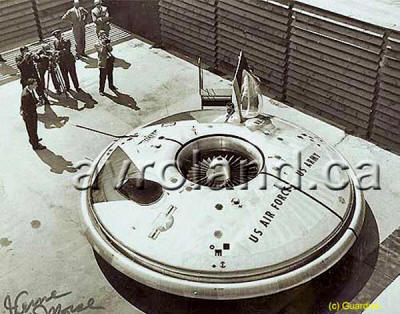
After the Air Force released the Avro
Saucer, which was nothing more than a glorified hovercraft driven by
a turbine engine... everyone had a good laugh... called it a joke or
a hoax... and went away.
People forgot about it... and UFO hunters
went back to looking for Aliens... though the public never did trust
the USAF after that...
If you wanted to hide a secret project, what better way than this to
befuddled the minds of the press and the people?
Seems it worked for
many years....
The Real Story
Excerpt
The Avro Canada VZ-9AV "Avrocar" designed by company Chief Designer
John Frost was a true flying saucer that was produced for the USAF and U.S. Army in the period 1958-1959.
In earlier research, Frost had
discovered the "Coanda Effect" provided a powerful ground cushion
envisioned as being the basis for a vehicle that could have both
have VTOL (vertical take-off and landing) capabilities and could
still operate as a high performance aircraft. Avro Canada and the
Canadian government provided the initial funding for Frost's work
1952- 1953.
He combined all of his innovative
technology into a disc shape which had been chosen as the most
efficient aerodynamic shape and to simplify structural requirements
for a circular hovering platform.
SOURCE: "The
Avrocar Story"
In other words, this was a working prototype, and early stage that
operated on the principles of a true flying saucer.
What is the Coanda Effect? It was discovered by Henry Coanda and is best
explained here at JLN Labs, a private group doing research into this
sort of technology.
They have working models and can show
you how to make one. Now before you run away, have a look at the
modern day flying saucer built by them. It is turbine driven. Also
keep in mind that air is a "fluid" as is plasma... (the key to all
saucer technology)
Have a look at the video below, they decide if the technology of the
Avro Saucer is "useless", then ask yourself,
"If this can be made in a home
tinker shop for a few hundred dollars, what has the Air Force
been able to do with this technology over the last 50 years?"
While it is true that research on the
air powered turbine forms were discontinued in 1961, there is much
material available on plasma experiments that would indeed be more
suited to a space capable saucer design.
As a side reference, here is a link to
current plasma technology from the Air Force Research Laboratory...
this is public information... remember those triangle UFO's that
have been spotted?
PLASMA ACTUATOR DESIGN
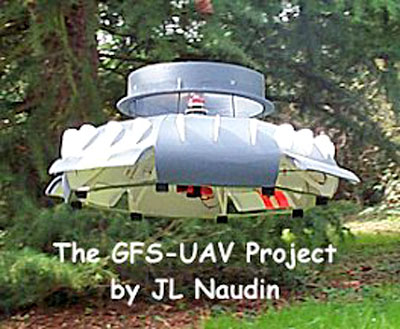
Do yourself a favor and go see the other
technology being explored by school projects and home scientists.
Visit JLN Labs. Now isn't it sad that
the Avro story comes from Canadian news media? And that this
backyard Tech is from France? This ought to make you take notice...
And the NAZI Saucers were said to use anti-gravity drive systems.
You can look this up yourself to see how far research has come along
this line, but in particular look at the "Searl Effect". This device
was tested in England in the 1960's! Look at the generator closely,
and compare it to the sketches of the Vril VII drive mechanism of
the Nazi plans above... (the picture is not a good copy but you will
get the point) and the Searl Effect Generator, or SEG.
Now for any of you that still doubt that we also understand anti
gravity, I direct you to "Project Lifter".
Again by JLN Labs, this is a simple
antigravity experiment that not only works, but can be duplicated in
college classrooms. People will say this model has no real lifting
power... true it IS a demo model, but the principle is the same, you
just need a powerful portable electric source.
Rest assured our government has such a
device.
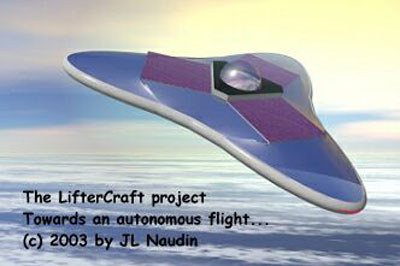
Below are links to actual anti gravity
lifter test videos, on even has a mouse as passenger, proving both
that lift capacity can be increases and that live animals suffer no
ill effects...
British Antarctic
Survey Mystery - Back to Antarctica
1966
Excerpt
After the first part of
Britain's Secret War in Antarctica was
published in the August/September edition of NEXUS (vol. 12, no. 5),
I was inundated with people and specialists in their field with more
substantiating information.
However, by far the most intriguing and
exciting was an email sent to me by Miles Johnston who investigated
a strange story about Antarctica with Danny Wilson whilst with the
Irish UFO Research Center. The center was contacted by an Eric
Wilkinson in 1975, who had reported a strange incident in 1966 when
he was with the British Antarctic Survey.
An even stranger photo backs up the
story (see above).
In Miles Johnston's own words, he
explains:
"In 1975 I investigated a
UFO/Strange Black Ray Cloud formation, taken by a Belfast member
of the British Antarctic Survey. He gave me some images of a
pulsing cloud formation firing a black ray into the ice, which
bounced off and reflected further away from him.
Who knows... maybe someone down
there is using negative energy beam weapons? Or was... since the
images were taken in 1966."
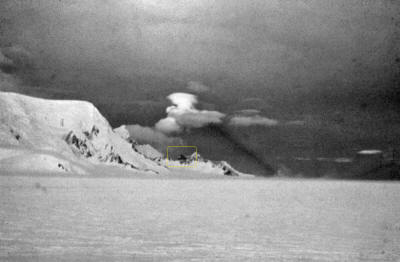
The photo [above] is
indeed enigmatic and substantiates the fact
that Antarctica and
Britain's role there are shrouded in mystery.
About the Author
James Robert is a
civil servant with an agency of the UK Ministry of Defense, as well
as a World War II historian and writer. He has traveled extensively
throughout North Africa and Europe to investigate mysteries of
Britain's secret wars.
With a family from a military background and with German sources
giving many so-called "myths" credence, he has set a personal
mission to delve deeper into the strange, suppressed, little known
and anomalous activities that were conducted before, during and
after the war against Germany.
"Britain's Secret War in Antarctica" has
been excerpted from his forthcoming book that will document some of
his investigations.
Conclusion
The above collection of facts has been gathered to show a sequence
of events that the general public has not been aware of. Most of the
material is well documented and references can easily be found.
It is our opinion at Pegasus that our
government has been involved in activities in Antarctica that
involve Nazi technology and perhaps Alien involvement and have been
going on since after the second world war.
If there is a secret base or mining operation on the moon, that is
in fact being conducted by parties from Earth, with or without Alien
participation or help, what better place than Antarctica from which
to conduct operations?
For this to be the case, that such a major operation is taking
place, it would be argued that there would be some trace of this...
This is a reasonable question. We have shown above the major
activity in the area after the war, and the most plausible reason
for it from actual historical facts...
Now review the notes that follow...
Pegasus Field
- Antarctica
1956 - Present
While doing research on the use of the name "Pegasus" we happened
across Pegasus Field in Antarctica. Naturally curious we wanted to
see what this place was about...
That's when we found many peculiar activities.
The results of our research are below,
taken from official sources that are available to the public. Though
they do NOT say they are running off world operations... the
question posed above was "evidence of major activity..."
Report #1 Images of Antarctica, Pegasus
Field Photos
2002 Seth White
This was our first exposure to Pegasus Field...
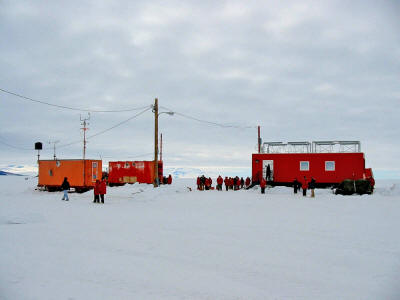
This is downtown Pegasus.
Pegasus Field is out on the Ross
Ice Shelf, about 15 miles from McMurdo. It sits directly between
Ross Island and Antarctica Proper, about 1/4 of the way to the
continent. This is where we land wheeled aircraft after the Sea Ice
Runway gets closed down in mid-summer. Although it is on the ice
shelf like Williams Field (which only supports ski equipped
aircraft), there is not nearly as much snow accumulation here.
So, you don't have to dig very far down
to find solid ice capable of supporting the high pressures
underneath wheeled aircraft.
I came out to Pegasus as a somewhat unauthorized visitor one day
late in the summer season. Pegasus is not like Willy Field - it only
grinds into action when a plane is coming. There are no shuttles
running here, so unless you have a reason to be here (i.e. part of
the flight ops crew, fire crew, or a passenger coming or going), you
can't really tag along.
But I was able to snag a ride out for
one of the last flights of the season anyway. I wanted to check out
the field in operation, since it would not be functioning by the
time I leave in October. On this day, a C-141 was landing. Three
airporter buses and Ivan the Terrabus were used to bring the
passengers out. I tagged along with one of the shuttle drivers in a
van containing the flight lunches for the passengers.
Here is a pic of the various shuttles
parked outside the passenger terminal.
This is the passenger terminal, or PAX terminal per the local slang.
It is just a little hut on skis that is dragged out here for the
summer season.
The bald guy in the front is Dave Havner,
who I didn't know at the time. He is one of the ATS crew and I have
gotten to know him over the winter. Since he was staying the winter,
he was headed out to Christchurch for a week of R&R on this
particular day. The regular McMurdo staff used to get this, but not
any more. However, the ATS guys still do.
This is where the C 141 came to rest. First order of business: get
the cargo off and start refueling.
Here are a couple Deltas and a loader, used to get the cargo off and
transport it back to town.
So why is Pegasus Field named Pegasus Field? Well, many years ago a
Navy Super Constellation aircraft named Pegasus crash landed near
here (1970, I think). It had a rough time coming in due to severe
weather, but the skill and experience of the pilots allowed the
plane to land with only bumps and bruises on the passengers.
The plane was not so lucky... its
starboard wing was broken off. The passengers and crew waited out
the storm after landing, and all was well (or at least as far as
plane crashes are concerned). The Navy salvaged all they could, but
they did not want to leave this wreck sitting near Williams Field
where it crash landed. Bad for morale, you know, to see a wrecked
aircraft right near the airstrip as you're flying in.
So they dragged it out farther on the
ice shelf and left it, as was the usual practice in those days. As
an aside, the Navy crews left a LOT of crap around in this area.
Winter Quarters Bay, where the various ships dock at McMurdo (and
where Scott originally moored the Discovery) is still extremely
polluted. The Navy simply bulldozed their trash into this bay.
They would also send out old dozers and
equipment on ice floes and dynamite them, leaving the wreckage to
sink to the bottom of McMurdo Sound.
Hut Point Peninsula and the nearby areas
of McMurdo Sound are probably the most polluted bits of land and sea
in Antarctica! Nowadays, spills and contamination are closely
monitored and contained. But there are still a lot of things left
over from the old days that nobody really wants to deal with, and
are more or less ignored.
Excerpts from Seth Whites trip to Pegasus Field. This report is
essentially from a "tourist" point of view, someone who had a chance
to go up there.
But as can be seen by the words above in
red, it made us more curious to whets going on up there
Addition
The approximately 100 passengers on the flight back to New Zealand
included a dozen or so Russian researchers who had been at Vostok
Station far inland in Antarctica, for 14 months, which is the normal
time for Russians to spend at their Vostok Station.
A U.S. LC-130s had flown them from
Vostok to McMurdo.
Source
Editors Note:
This report is from a "tourist" point of view, yet reveals many
interesting facts. Pegasus Field is used to land heavy transports on
the ice, and also supplies the Russian Vostok Station.
Vostok
Station was also mentioned in the 1946 Antarctic activities. Seems
the Russians are still as active there as well.
Pegasus Field,
Antarctica - Scouring Old Wounds
2000 - 2001
by Kristan Hutchison
Sun staff
Article on antarcticsun.usap.gov
Excerpts
McMurdo has seen cleaner days, and much, much dirtier...
In 1994, soil samples from around the station pinpointed six hot
spots with at least 10,000 parts per million of total petroleum
hydrocarbons, 100 times the maximum allowed in the United States.
As might be expected, the worst areas at
McMurdo were the sites of fuel tanks, pipelines and the helicopter
pad...
"There's lots and lots and we've
gotten to a few," Gilmore said.
"It's really contaminated," Gilmore muttered, reading the
results of soil samples from the playhouse site. "But we knew it
would be."
The playhouse was once used as an
equipment repair shop, in the days before mechanics worried about
fuel and waste oil draining into the ground.
The total petroleum hydrocarbons in the
soil samples are as high as 15,000 parts per million. In the United
States soil cleanup is mandated if the contamination is above 100
parts per million. The soil from the playhouse site will be removed
this season and stored in berms covered with heavy plastic.
Eventually Gilmore hopes to bring in equipment to clean the fuel
drenched dirt stored near the fuel tanks...
Already the environmental department has removed 2,000 tons of fuel
contaminated soil and 697 drums of fuel, ice and soil from McMurdo
in the past two seasons. The drums and fuel were shipped north,
while the soil was piled into berms...
The garbage and spilled fuel had been accumulating since the station
was established in 1956, Gilmore said. Back then nobody thought
about the environment. They dumped garbage on the ice in Winter
Quarter's Bay or buried it in the nearby hills.
Sewage is a big exception. The station produces 40,000 to 60,000
gallons of sewage a day, depending on the season. The sewage is
chopped into sludge, diluted with brine and water from the Crary Lab
and released into McMurdo Sound.
Debris was already removed from Marble Point and cleanup continues
around Pegasus field. Later this season Gilmore's team will assess
an abandoned research station at Cape Hallett in order to plan for
its cleanup.
Gilmore suspects hazardous waste lingers
among the collapsing buildings and debris, putting the nearby
rookery of 180,000 pairs of penguins at risk.
Editors Note: The
above major cleanup effort says two things of importance. The first
is that major activity has been going on here since 1956; Second,
judging by the amount of waste produced daily today there is still
ongoing major activity. The sheer quantity of waste, contaminated
soil, fuel spills and metal dynamited to the ocean floor is proof of
something major taking place. Both these articles mention the Navy
as the main players in the region since 1956
Pegasus Field,
Antarctica
February 20, 2002
Runway Project Clears the Way for Improved Antarctic Airlift
National Science Foundation
NSF PR 02-14 - February 20, 2002
Media contact: Peter West (703) 292-8070 pwest@nsf.gov
Editors Note: The links below are to Air Force fact sheets regarding
the capacity of the planes landing here.
The U.S. Air Force has certified a newly constructed glacial ice
runway near Antarctica's McMurdo Station as capable of handling
large military cargo jets.
The certification marks an important
improvement in the U.S. Antarctic Program's (USAP) ability to
support science research for the National Science Foundation on
Earth's southernmost continent.
A U.S. Air Force C-141 Starlifter cargo plane landed safely on the
compacted snow pavement of the existing Pegasus runway near the
USAP's logistical hub at McMurdo on Jan. 29 (local time). Among the
aircraft's 103 passengers was Charles J. Swindells, the U.S.
ambassador to New Zealand, on his way to visit USAP installations
and field camps. (U.S. Stations in Antarctica keep New Zealand
time.)
Preparation of the runway pavement required the use of 100 ton
pneumatic tire rollers to compact a thin snow cover, turning the
snow into white ice, a material sturdy enough to handle four engine
military transport aircraft.
The addition of this white ice pavement allows all season landings
of wheeled aircraft in the Antarctic for the first time in history.
Currently, ski equipped LC-130 Hercules cargo aircraft flown by the
New York Air National Guard transport much of the cargo and many of
the passengers to Antarctica. The new runway greatly enhances
airlift capabilities to support USAP activities.
The newly developed compaction process protects the runway from sun
damage while having the structural strength necessary to withstand
the stresses imposed by the landing of large aircraft such as the
C-5 Galaxy, one of the world's largest aircraft: the C-17 Globemaster, the newest air force cargo plane; and the older C-141s.
Without a cover of snow as protection, the warm temperatures and
high sun angles during the height of the Antarctic summer would have
damaged the runway.
Prior to the U.S Air Force's certification of the Pegasus runway to
handle the larger cargo aircraft, wheeled aircraft were able to land
on the continent only very early and very late in the research
season on runways that at other times of the year are useable only
by ski equipped planes.
The principal austral summer research season begins in October and
ends in February.
The National Science Foundation operates the U.S. Antarctic Program,
which coordinates almost all U.S. scientific activity on the
continent.
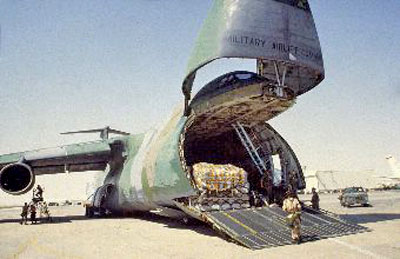
Photo Credit USAF
C-5 GALAXY
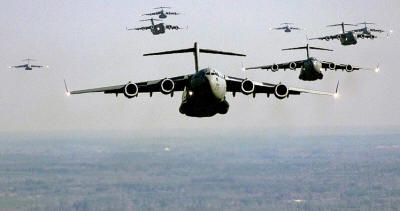
Photo Credit USAF
C-17 Globemaster III
Editors Note: Why do
they need to bring in so many giant transport planes? At the very
least this is indication of major operations in the area. The other
really interesting factor is that the company that runs the cargo
operations is Raytheon, a major defense contractor
Raytheon Polar Services Company:
"Raytheon Polar Services exists
specifically to meet the needs of the National Science
Foundation (NSF) Office of Polar Programs. The main function of RPSC is to provide support to the United States Antarctic
Program, which is dedicated to sustaining the Antarctic
environment and funding scientists who conduct research in
Antarctica."
Mission Statement
Raytheon Main Company Site - A
major defense contractor
Interesting Theories
Many of us at Pegasus Research
Consortium have been researching the possible existence of Star
Gates and seeking evidence.
All this info is found at The Star
Gates. The TV series Stargate SG-1 contains many interesting
notions that indicate the writers have "inside" knowledge
(covered in those pages), but as a curious side note to our
research here, they discovered an Ancient Base beneath
Antarctica that lead to Atlantis through a
Stargate to another
Galaxy.
The premise of Stargate is that the
US Air Force has been maintaining off world bases and has been
interacting with Aliens for some time, without the knowledge of
the public. It is further note worthy that the Russians are
prominent players as well.
And a major battle took place between Earth forces and the
Aliens OVER ANTARCTICA, littering the area with debris. Pure
coincidence perhaps, but the series has advisers from The US Air
Force, The Space Command and the Department of Defense listed in
their credits. Is it possible that they are using this media to
tell us what's really going on to ease the shock of reality when
it the truth finally comes out?
It is also interesting that the
series did a spoof "Stargate" show themselves, and General
Hammond commented that they should leave the program alone,
because if anyone ever discovered anything, we can always point
to the TV show... It wouldn't be the first time Hollywood has
been used for propaganda.
Vladimir Terziski
President, American
Academy of Dissident Sciences,
German Bases on the Moon and Mars
Mining the Moon - How
could they do it?
A remote location would definitely be required. The evidence above
indicates that not only is there activity at such a remote location
as Antarctica, but there has been since the second World War...
Signs of heavy equipment moving would seem logical. The evidence
above shows such activity, with the addition of adding the largest
air transport plane in the world to make flights to and land on the
ice at Pegasus Field... There is mention of ATS personnel
movement... There is proof positive of 50 plus years of major
contamination to the area by military operations...
While there is not yet any proof that they are making covert trips
to the moon and back, we have shown that the logistics indicate a
huge scale operation taking place.
Mining Machinery... The equipment needed to strip mine on the moon
would indeed be massive, as those machines can be enormous indeed...
People have argued,
"How could they ship such machines to the moon?"
First of all lets look at one...
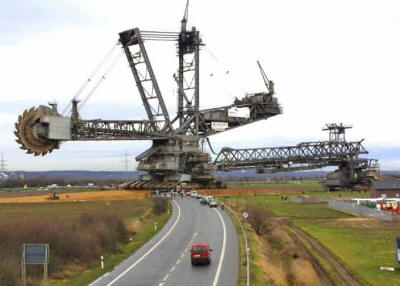
This is the largest
digging machine (or trencher or rotating shovel) in the world.
It was built by Krupp
and is shown here crossing a road in Germany
on the way to its
destination, an open air coal mine.
Although at the mine
the treads are unnecessary,
it was cheaper to
make the machine self-propelled than to try and move it
with conventional
hauling equipment.
SOURCE
Yes they are HUGE, but they start as pieces.
At a recent Mining Equipment Show in Las
Vegas I witnessed them build a huge machine, not as big as this one,
in the parking lot... it took 12 days to assemble.
The point is shipping to the Moon would
have to be done in parts, and assembled there. It is also likely
that given the time frame of 50 or so years, that IF such a major
operation was happening up there, they would have created a facility
to manufacture equipment by now on location, requiring only
supplies, parts and man power
As to what mode of transport they are using to GET to the moon, we
believe that it would have to be anti gravity related of some type.
This is the only plausible way that this would work.
Since it has been shown above that,
-
The pre-war scientists were
already working on the theories (works of
Nikola Tesla,
Moray, et al)
-
There is evidence of anti
gravity technology in the Nazi secret programs...
-
There is
antigravity
experiments that work and can be duplicated by lay people
with only a little knowledge and expense (small scale true,
but scale is a function of funding)
So in the end it is POSSIBLE that this
is taking place.
Proof comes from gathering a wealth of
evidence and piecing the puzzle together piece by piece. The picture
already is to big to be mere coincidence, and more is coming to
light as documents reach declassification dates, participants retire
and start to speak out, and more researchers seek the answers. The
internet is a powerful tool to gather and disseminate information,
but it can also be used equally well to spread disinformation and
propaganda.
We must keep our mind and eyes open,
check everything twice, but not be too ready to dismiss everything
as a hoax or talk by lunatics.
We have shown above that all this is POSSIBLE by using HUMAN
ingenuity and technology...
IF you were to factor in outside help from an Alien civilization,
the picture naturally changes drastically. If it COULD be done
within HUMAN means, imagine the possibilities and how far along they
are today with such help. And if indeed they have been around since
the second world war or earlier... we better HOPE that it IS our
government that is involved, no matter how much you may distrust
them, its better US than THEM
It is likely though that some level of knowledge or participation of
some other governments is likely, the best case going with Russia.
It is our belief that Russia has actually been a behind the scenes
ally for some time. In the public on both sides we are "enemies" yet
I bet that secretly they are, and have been since the cold war
started, friendlier than admitted.
Hollywood movies like James Bond
hint at that,
Stargate directly says it...
Just look at the current space program... I have heard a lot of
Russian on NASA TV lately... Pizza Hut, Radio Shack and Lego
advertize with the Russian Space program.
That and tourism have helped pay
Russia's way to space, and don't forget who took those back side of
the moon pictures.
Bigelow Aerospace of Las Vegas went to launch in
Russia when NASA said they couldn't (or wouldn't) do it...
So... sit back and enjoy the chat rooms... go work so you can pay
your taxes... and everything will be fine... everything is under
control....
Back to Contents
Part 2
Mining Connections
Mining Connection #001
What Are They Mining?
-
Titanium - Iron - Ilmenite:
A sample obtained from the Mare Tranquillitatis lunar region by
Apollo 11 astronauts "Buzz" Aldrin and Neil Armstrong. This basaltic
lava sample is high in iron and titanium.
A sample collected from the Oceanus Procellarum mare region by
Apollo 12 astronauts. Studies conducted on this sample indicate
that this is a low titanium, medium grained, olivine basalt that
possesses an exceptionally high magnesium content.
Large pyroxene oikocrysts surround numerous rounded olivine crystallites, and
patches of glomerophric olivine are present in some areas. The
sample is composed primarily of the minerals olivine, plagioclase
and pyroxene with a trace amount of opaque material.
Chemically, the rock is about
42% silicon dioxide, 22% ferrous oxide, with the rest being
mainly magnesium, calcium, and aluminum oxides.
(Source)
-
Limonite - Chemical Formula: FeTiO3, Iron Titanium Oxide. In the
processing of this ore free oxygen that can be used for breathing
and rocket fuel manufacture is released as a byproduct. The ore
yields iron and titanium
(Source)
-
Iron - in the form Ferrous Oxide - yields Iron and releases free
oxygen.
(Source)
-
Glass - Quartz - Silicon Dioxide:
Quartz - Chemistry: SiO2, Silicon dioxide - used in glass making
and releases free oxygen in processing.
(LUNAR AND MARTIAN FIBERGLASS AS A VERSATILE FAMILY OF ISRU VALUE
ADDED PRODUCTS)
-
Water - H2O:
Though generally not referred to as a Mineral, water is in fact just
that. The solid form being ice, water is the liquid state of the
mineral, in the same way mercury exists as an element in liquid form
at normal temperatures.
The initial estimate of the amount, to be determined more accurately
with later observations, is 30 to 300 million metric tons (recent
thinking has raised the upper limit to perhaps as high as 3 billion
tons). If melted, this larger number would fill a "lake" 10 square
kilometers in area (3.1 x 3.1 km) to a depth of 10 meters.
(Source)
-
Zinc:
The orange soil was brought back from the Taurus-Littrow landing
site by the Apollo 17 crewmen. Scientist/Astronaut Harrison H.
Schmitt discovered the orange soil at Shorty Crater. Like those
samples, it is rich in titanium (8%) and iron oxide (22%). But
unlike the Apollo 11 samples, the orange soil is unexplainably rich
in zinc.
(Source)
Note: Gravity Shielding Experiments at Los Alamos National
Laboratory Using ZnS (A Gravitational Shielding Based upon ZnS: Ag Phosphor)
Note: ISRU means In Situ Resource Utilization, in other words what
is on the Moon stays on he Moon. Mining operations to support a Base
or Colony on he Moon would require materials for construction Etc.
Most of the mining, colonization, and base construction plans at LPI
talk in terms of ISRU, NOT returning the minerals to Earth. Many
people following our mining on the moon theory argue that it would
be too costly and to difficult to transport to Earth. Seems they
don't intend to.
-
That brings up Helium 3.
Any operations on the Moon and Mars plus
transport to and from would require a good source of power. Helium 3
is that source... clean, relatively safe and in abundance on the
moon. While 25 tons could supply the entire US power needs for one
year, this too will most likely be ISRU, making new Helium Barons on
the Moon...
Helium 3 - He3:
In their 1988 paper, Kulcinski, et al. (see ref note below),
estimate a total of 1,100,000 metric tonnes of He3 have been
deposited by the solar wind in the lunar
regolith. Since the
regolith has been stirred up by collisions with meteorites, we'll
probably find He3 down to depths of several meters.
That amount of He3 would produce approximately 20,000 terra watt
years of thermal energy, about 10 times the amount if we burned all
the fossil fuels on Earth. without the pollution. Another way to
state it, 25 tons would power the United States for 1 year, which is
about the maximum size of the payload of a Space Shuttle.
(Source)
How can they use the Helium 3?
MIT is working on a model for a Helium 3 powered Levitated Dipole
Fusion Reactor.
Researchers find new source of coherent light:
A "Wheel within a wheel..." (Levitated Dipole Fusion Confinement Concept - MIT Plasma Science &
Fusion Center)
-
Thorium:
Thorium as a nuclear fuel.
Thorium, as well as uranium and plutonium, can be used as fuel in a
nuclear reactor. Although not fissile itself, 232Th will absorb slow
neutrons to produce uranium 233 (233U), which is fissile. Hence,
like 238U, it is fertile.
In one significant respect 233U is better
than the other two fissile isotopes used for nuclear fuel, 235U and
plutonium 239 (239Pu), because of its higher neutron yield per
neutron absorbed.
Source
The interesting thing is that the majority of these valuable
Minerals are found in the heaviest concentrations around Copernicus
Crater.
Mining Connection #002
Who Owns the Mineral Rights?
Three people!!!
However, a loophole in Space Law allows individuals and companies to
hold Mineral Rights on the Moon, Mars and other celestial bodies.
Growing concern from Scientists that these rights may be held
hostage have been alleviated by a three man North American team:
...who have acquired the mineral rights for 95% of the side of
the moon that faces Earth, the polar regions and 50% of the far side
of the moon. - Source
Dr. Resnick found the loophole in Space Law 25 years ago that
allowed him ownership of all planetary bodies outside the "Third
Planet from the Sun"... submitted this to the World Court at the
Hague, and to the United Nations in New York City.
In 25+ years no
one has ever disputed Dr. Resnick's claimed ownership.
Source
Mining Connection #003
In 1960, the USGS established an astrogeology program on behalf of
NASA to support lunar and planetary exploration.
A prime activity of
the program is the systematic mapping of the stratigraphy and
structure of the Moon, Mars, Venus, Mercury, and the moons of the
outer planets.
Many USGS maps of the Moon, Mars, Mercury, Venus, and the moons of
Jupiter and Saturn are now available for purchase by the public.
These maps are in the Miscellaneous Investigations (I) Series.
The maps include geologic, topographic, photo mosaic, and shaded
relief maps.
The scales, projections, and sheet sizes of these maps vary widely.
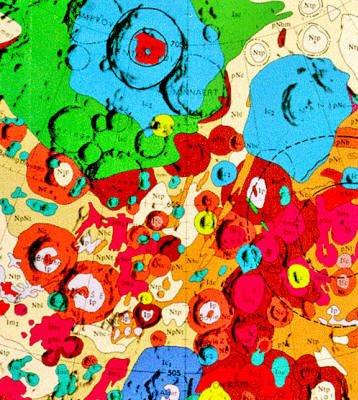
Comments
So 9 years BEFORE Apollo the USGS was already creating topographical
and mining maps of the Moon - Zorgon
SOURCE
Mining Connection #004
USGS 1967
After some intensive searching I have found the full scale original
USGS Lunar topographical and mining maps of the Moon. The one
specific to Copernicus crater is below.
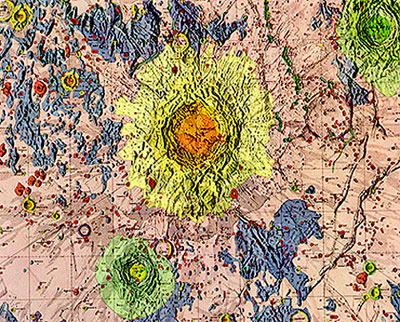
Comments
What is most significant about these maps is the size and detail...
and the fact that they were created in 1967, two years before we
landed on the moon. The other interesting thing to note is the names
of the creators of the map...

Mining Connection #005
Ancient or Alien Technology
Since it is our position that the mining operation on the moon was
an exiting operation that we merely took over, it would be logical
to assume that there would be technology in place that we have
"discovered" and in that case would in effect be "mining for
technology".
The fact that the moon would preserve anything for a
long period of time that isn't left exposed on the surface, could
mean that we would find a lot of invaluable equipment and technology
from either an Ancient Race or from some Alien Civilization that was
here before...
Back to Contents
Part 3
More Afoot in Antarctica
The items on this page are a collection of various interesting
activities in
Antarctica. Though they have been included because
they are relevant to our research, they have not yet been classified
nor "painted into the big picture"
Antarctica Connection #001
South Pole Death Mystery - Who killed Dr Rodney Marks?
Sunday Star Times, Auckland, New Zealand
Sunday, 21 January 2007
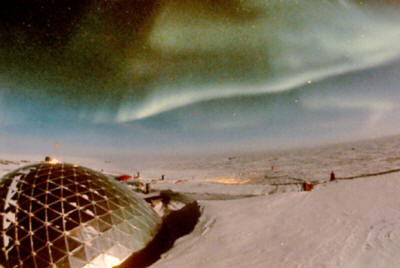
Image Courtesy of The University of Iowa Department of Physics &
Astronomy
Scientist Rodney Marks died at the South Pole in May 2000.
Months
later, tests showed he had been poisoned by a lethal dose of
methanol.
Dogged efforts by New Zealand authorities to investigate
his puzzling death have been stonewalled by Marks' American
employers. Now documents obtained under America's Freedom of
Information Act suggest diplomatic heat is being brought to bear on
the NZ inquiry, Andrea Hotere reports.
An American government department appears to be applying diplomatic
pressure to the New Zealand police investigation into the mysterious
death of an Australian scientist poisoned at the South Pole.
Police have said Dr Rodney Marks, a brilliant young astrophysicist
who died in 2000 from a lethal dose of methanol, may have been
murdered. They said suicide was "the least likely scenario" to
explain his death.
But New Zealand investigators have been frustrated by a lack of
co-operation from the National Science Foundation (NSF), the US body
that runs the US Antarctic program and for whom Marks, 32, worked.
The death is being investigated in New Zealand with the agreement of
American and Australian authorities, and Christchurch coroner
Richard McElrea has adjourned his inquest.
Documents obtained by the Sunday Star-Times under America's Freedom
of Information Act include a letter sent last month by Christchurch
investigating officer, detective senior sergeant Grant Wormald, to
the NSF.
Wormald wrote:
"I am aware that Mr Blum (actually Bloom) of the
United States State Department has written to Mr Trevor Hughes from
the New Zealand Ministry of Foreign Affairs and Trade (MFAT)
questioning my perseverance in the conducting of this enquiry."
Wormald had earlier told the inquest into Marks' death that police
had spent four years trying to get information from the American
authorities that appeared to have investigated the death, but it was
unclear how far their inquiries went.
No significant reports from NSF, or its contractor, Raytheon Polar
Services, who ran the South Pole station, were available. Raytheon
Polar Services is an offshoot of the multi-billion-dollar Raytheon
Company Ltd, a US defense and aerospace systems supplier.
Any information would have helped police and consequently the
coroner's inquiry, Wormald said.
Last week, Wormald would not comment on why he had written in those
terms to NSF, but Green Party foreign affairs spokesman Keith Locke
said the letter's content appeared to indicate diplomatic pressure.
He said whatever doubts American authorities had about jurisdiction
issues, they had a moral obligation to,
"offer the fullest
cooperation and encourage full investigation, especially when a
person dies in strange circumstances".
MFAT's policy unit head Trevor Hughes said the letter expressed
Wormald's interpretation, which he said was incorrect.
Hughes said
the NSF had done more than it was obliged to do to co-operate with
the New Zealand police investigation; his legal advice was that the
NSF only had to cooperate voluntarily.
The Freedom of Information Act documents add to the police's
confusion about what investigations were done into Marks' death by
the US organizations.
NSF spokesman Jeff Nesbit last week told the Star-Times that the NSF
had not investigated Marks' death; the only investigation done was
medical.
But a letter dated June 15, 2005, by Dr Karl Erb, Director of the
Office of Polar Programs, states:
"A great deal of time and effort
has gone into the analysis (of Marks' death)."
Another letter, dated December 1, 2006 from Wormald to the NSF,
suggests his most recent inquiries from people at the station when
Marks died revealed that all ethanol bottles and a still for
producing alcohol of some sort had been found and repatriated to the
US by the NSF.
The documents also include the police survey sent to the 50 people
at the Pole when Marks died. It includes questions about intravenous
drug use (at the inquest in December, it was reported Marks had
three needle marks in his right arm) and drinking games at the
station.
Nesbit said Raytheon Polar Services, as the NSF's contractor for
Antarctic services, assumed all "audit, accounting and
responsibility" and was responsible for medical care that Marks
received.
SOURCE
Comments: The article has been removed
from the original source.
Antarctica Connection #002
Training in Antarctica for Mars Missions
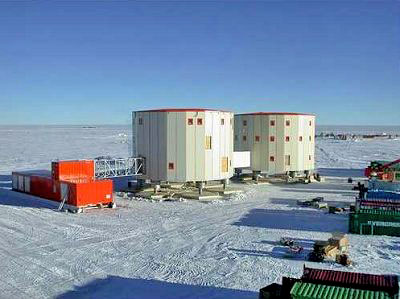
European Space Agency
Mission to Mars via Antarctica
21 December 2005
The Concordia Station is a scientific base built in Antarctica
by
the French Polar Institute (IPEV) and the Italian Antarctic
Programme (PNRA)
A few weeks before leaving for the Antarctic Concordia Station, the
Italian-French crew that will spend over one year in one of the
harshest, isolated environments on Earth, attended two days of
preparatory training at
ESA's Headquarters in Paris, France.
During
their stay at the research station the crew will participate in a
number of ESA experiments - the outcome of which will
help prepare for long-term missions to Mars.
As part of the Aurora Exploration Program, ESA is considering
participating in a human mission to Mars by the year 2030. Research
projects are planned or are already underway to develop the
technology and knowledge needed.
By being involved in programs
that have requirements similar to those of a mission to Mars, ESA
will gain experience on how best to prepare for such a challenging
mission.
"The Concordia Station is an ideal location as it replicates certain
aspects of a Mars mission," explains Oliver Angerer, ESA's
coordinator for the Concordia research program.
"The crew lives in
an extreme environment in one of the most remote places on Earth.
During the winter the base is completely cut off with no visitors
and no chance for rescue. In such an isolated location, the crew has
to learn to be fully self-sufficient."
Built and operated jointly by the French Polar Institute (Institut
Paul Emile Victor, IPEV) and the Italian Antarctic Program (Consorzio
per l’attuazione del Programma Nazionale di Ricerche in Antartide,
PNRA SCrl), the Concordia Station was completed in 2004.
A letter of
intent was signed with IPEV and PNRA in 2002 that enabled ESA to
cooperate on some aspects of the project.
Capable of providing home to up to 16 crewmembers in the winter, the
station consists of three buildings, which are interlinked by
enclosed walkways. Two large cylindrical three-storey buildings
provide the station's main living and working quarters, whilst the
third building houses technical equipment, like the electrical power
plant and boiler room.
Last November, the first crew finished their winter-over which was
dedicated to the technical qualification of the station. The summer
season sees a swelling in the number of inhabitants as short-stay
scientists take advantage of the less extreme weather (however, mean
air temperature is about -30°C during this time!).
With the second
crew now starting to gather at the remote research station, the
summer season also marks a change over of the crew.
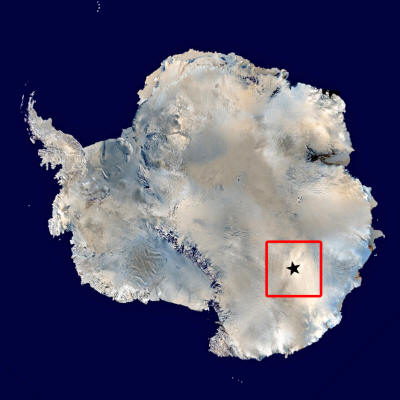
Map of Antarctica showing Dome-C (red square) and location of
Concordia Station (star).
Credits: Mark Drinkwater, ESA
Briefings
Three scientists who are part of the next Concordia winter-over crew
have already made the long journey to Antarctica.
The rest of the
crew, who will leave for the Antarctic research station during
December, gathered at ESA's Headquarters in Paris for two days of
pre-departure training. They received briefings about life at
Concordia, including aspects such as safety and the implications of
the Antarctic Treaty for activities at the station.
The seven crewmembers also heard about research at the station,
including two special experiments for which they will act as
subjects during their stay. In 2003, ESA coordinated together with
the Concordia partners a Research Announcement for medical and
psychological research, from which six proposals were selected.
The two experiments, which are the first to be implemented in the
coming season, look at psychological adaptation to the environment
and the process of developing group identity; issues that will also
be important factors for humans travelling to Mars. For this
research the crew will complete questionnaires at regular intervals
throughout their stay.
ESA's Mistacoba experiment, which already started a year ago when
the first crew started living at the station, will also continue
after the crew rotation. Starting from a newly built clean
environment, samples are taken from fixed locations in the base as
well as from crewmembers themselves.
The Mistacoba experiment will
provide a profile of how microbes spread and evolve in the station -
an isolated and confined environment - over time.
To protect the Antarctic environment, all waste materials must be
removed from the Continent. For the Concordia Station, this means
that all waste materials have to be appropriately treated. Regarding
water, based on ESA life support technologies, ESA developed,
together with PNRA and IPEV, a system to recycle the so-called 'grey
water' collected from showers, laundry and dishwashing, which has
been operating for a year in line with the requirements of the
Concordia partners.
Other ESA activities for Concordia include the ongoing development
of a system to monitor the health and well being of the crew, part
of the Long Term Medical Survey (LMTS). Physiological parameters,
collected using a vest-like item of clothing, will provide valuable
data about the health and fitness of crew during long-term stays in
harsh environments.
Real environment
In mid-February the last plane of summer visitors will depart from
Concordia leaving the crew to their own devices.
"For those nine
winter months the crew will experience extreme isolation," adds
Oliver Angerer. "Concordia is a real operational environment,
something we would never be able to simulate in a laboratory. This
will enhance and complement our research and give us valuable
insight we need to prepare for Mars."
SOURCE
Antarctica Connection #003
Malin Space Systems Antarctic Research
Introduction
Mike Malin, MSSS President, began research in Antarctica during the
1982-1983 austral summer, while a member of the faculty in the
Department of Geology at Arizona State University in Tempe, Arizona.
This page, and references within, illustrate aspects of this
research effort.
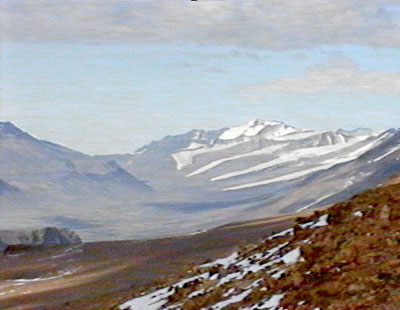
Background
The Antarctic environment is particularly harsh, but recent studies
suggest that the absence of significant amounts of liquid water
allow landscapes to be preserved for significantly longer than found
elsewhere on Earth, and indeed longer than previously thought.
Malin's study is designed to establish, over a timescale relatively
long for human activity (~50 years), the effects of chemical and
physical weathering on naturally occuring materials in many
different microenvironments in the Antarctic ice-free valleys.
Eleven sites were established ten years ago by deploying over 6000
individual samples of well characterized rock materials ranging in
physical properties from soft non-welded pyroclastic tuff to
extremely hard, fine-grained dolerite and coarse-grained granite.
Samples were deployed on racks above the surface, on the surface,
and beneath the surface, to accumulate the effects of chemical and
physical processes over many years. Included are 2.5 cm diameter,
0.5 thick disks of rocks deployed at 7, 14, 21, 35, and 70 cm above
the surface and facing N, E, S, and W, 8 cm cubes, and 5 cm long by
2.5 cm diameter cylinders.
Samples have been returned after one year exposure and five years
exposure. The purpose of 1994's effort was to recover materials that
have been exposed for ten years. Samples remain in place that can be
recovered later, nominally after 15, 20, 30, 40, and 50 years.
This research was and is supported by the National Science
Foundation's Antarctic Program.
Papers Reporting Results of Antarctic Research Program
-
1983 - Preliminary abrasion rate observations in Victoria Valley,
Antarctica
-
1984 - Abrasion rate observations in Victoria Valley, Antarctica:
340-day experiment
-
1985 - Rates of geomorphic modification in ice-free areas southern
Victoria Land, Antarctica
-
1986 - Solution etch pits in dolerite from the Allan Hills
-
1987 - Abrasion in Ice-Free Areas of southern Victoria Land,
Antarctica
-
1991 - Short-term Variations in the Rate of Eolian Processes,
Southern Victoria Land, Antarctica
-
1994 - 30 Years of Measurements of Sand Wedge Growth in Lower
Wright Valley, Antarctica
SOURCE
Antarctica Connection #004
Snow Cruiser
U. S. Antarctic Service under Admiral Byrd's Command
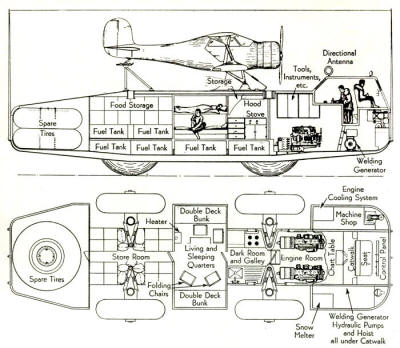
The immediate purpose of
the Snow Cruiser, however, as part of the
U. S. Antarctic Service under Admiral Byrd's command, is to speed up
exploration work and scientific investigation as well as to claim
the continent as a United States possession by maintaining colonies
there for three years as required by international agreement.
Assisted by a five-passenger airplane, it is believed that the Snow
Cruiser will add as much to the knowledge of the South Polar regions
in two or three months as all previous expeditions combined.
This
plane, along with others, is expected to map most of the South Polar
Continent by means of aerial cameras.
The Snow Cruiser, world's
newest and largest automobile, has almost nothing in common with
conventional cars except that it runs on four pneumatic tires, but
even this comparison is not exact because the tires are so large and
soft that a spring suspension is unnecessary.
Unlike an ordinary
car, it has two engines instead of one, four-wheel drive, four-wheel
steering by two levers instead of a steering wheel, two accelerator
pedals, two brake pedals, a built-in hydraulic jack on each wheel,
enough Diesel fuel for a 5000-mile run (2500 gallons), 1000 gallons
of airplane gasoline, bunks for four men and food for a year.
SOURCE
Antarctica Connection
#005
Glass Dome in Antarctica - A Photo Tour
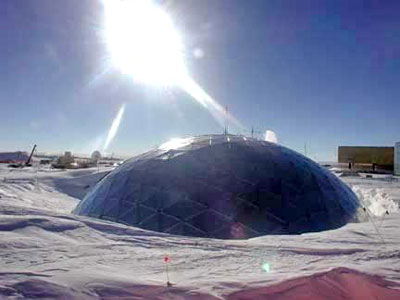
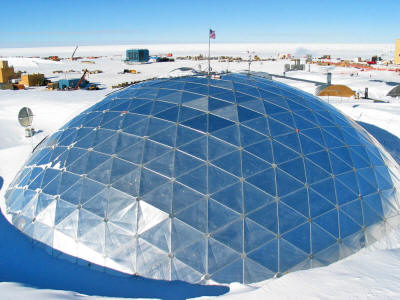
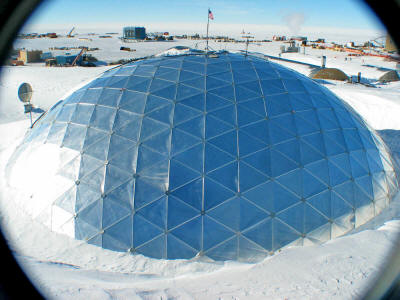
DOME HISTORY
"A New Research Station at the South Pole"
(Text and Photos Copied from the March/April 1975 Issue of the
Antarctic Journal)
Written By Guy G. Guthridge
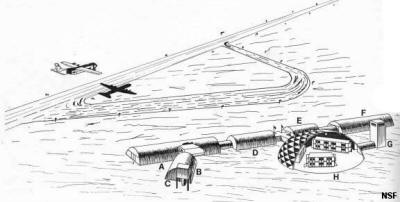
Artist’s concept of the new station’s design:
-
Garage, mechanical
shop, and gymnasium
-
Helium storage
-
Weather balloon inflation
and launching tower
-
Diesel-electric generators and maintenance
shop
-
Biomedical and medical facilities
-
Fuel storage
-
"Skylab" tower for all-sky photography and other atmospheric
studies
-
Geodesic dome enclosing three buildings:
-
building 1 -
(clockwise from the top) science facilities and quarters
-
building
2 - communications equipment, store, lounge, and library
-
building 3 - kitchen, dining
hall, post office, photographic laboratory, and meeting
hall
SOURCE
Antarctica Connection
#006
Amundsen-Scott South Pole Station
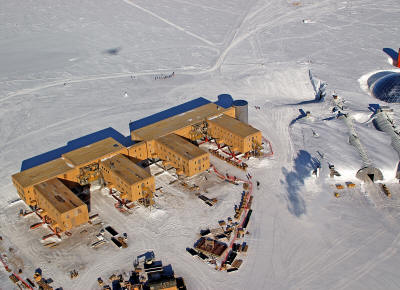
Amundsen-Scott South Pole Station
Aerial view, January 2005.
The Amundsen-Scott South Pole Station is a U.S. research station at
the South Pole, in Antarctica.
Description and history
It is the southernmost continually inhabited place on the planet.
Its name honors
Roald Amundsen and
Robert F. Scott, who reached the
South Pole in 1911 and 1912.
It was constructed in November 1956 to support the International
Geophysical Year in 1957, and has been continuously occupied since
then. It currently lies within 100 meters (330 feet) of the
Geographic South Pole, and drifts towards the pole at the rate of
about 10 meters per year.
Although the US has continuously
maintained an installation at the South Pole since 1957, the central
berthing, galley, and communications units have been constructed and
relocated several times. Each of the installations containing these
central units has been named the Amundsen-Scott South Pole Station.
Snow accumulation is about 60-80 millimeters (water equivalent)
per year (3 in/yr). The station stands at an elevation of 2,835
meters (9,301 ft) on interior Antarctica's nearly featureless ice
sheet, about 2,850 meters (9,350 ft) thick at that location.
Recorded temperature has varied between -13.6°C (7.52 °F) and -82.8°C (-117°F).
Annual mean is -49°C (-56°F); monthly means vary
from -28°C (-18°F) in December to -60°C (-76°F) in July.
Average
wind is 5.5 m/s (12 mph); peak gust recorded was 24 m/s (54 mph).
Original station (1957 - 1975)
The original South Pole station, now referred to as "Old Pole", was
constructed by an 18-man United States Navy crew during 1956 - 1957.
The crew landed on site in October 1956 and was the first group to
winter-over at the South Pole, during 1957. Since the winter
conditions at the South Pole had never been measured, the station
was built partially underground in order to protect it from the
worst imaginable weather. The low temperature recorded during 1957
was -74°C (-102°F).
These temperatures, combined with low humidity
and low air pressure, are only manageable with proper protection.
As with all structures at the South Pole, the original station
caused wind-blown snow to build up in the surrounding area. This
snow accumulation resulted in the structure being further buried by
about four feet of snow per year. The station, abandoned since 1975,
is now deeply buried, and the pressure has caused the mostly wooden
roof to cave in.
The site is therefore a hazardous area and off-limits to all visitors.
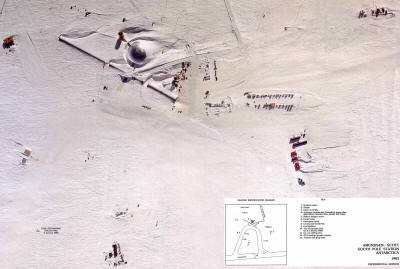
An aerial view of the Amundsen-Scott South Pole Station taken circa
1983.
The central dome is shown along with the arches, and various
storage containers and support structures.
Dome (1975 - 2003)
An aerial view of the Amundsen-Scott South Pole Station taken circa
1983. The central dome is shown along with the arches, and various
storage containers and support structures.
The station was relocated and rebuilt in 1975 as a geodesic dome 50
meters wide and 16 meters high that, with 14 m × 24 m steel
archways, covers modular buildings, fuel bladders, and equipment.
Detached buildings within the dome house instruments for monitoring
the upper and lower atmosphere and for numerous and complex projects
in astronomy and astrophysics.
The station also included the skylab,
a box-shaped tower slightly taller than the dome and accessible by
tunnel. The skylab housed atmospheric sensor equipment and later a
music room.
During the 1970-1974 summers, the dome construction workers were
housed in Korean War tents, or "jamesways".
These tents consist of a
wooden frame with a raised platform covered by canvas. A double-doored
exit is at each end. Although the tents are heated, the heating
power is not sufficient to keep them at room temperature during the
winter. After several jamesways burnt down during the 1976-1977
summer, the construction camp was abandoned and later removed.
However, starting in the 1981-1982 summer, extra seasonal personnel
have been housed in a group of jamesways known as "summer camp".
Initially consisting of only two jamesways, summer camp now has 11
berthing tents housing about 10 people each, two recreational tents
and bathroom and gym structures. In addition, a number of science
and berthing structures, such as the hypertats and elevated dorm,
were added in the 1990s, particularly for astronomy and
astrophysics.
During the period in which the dome served as the main station, many
changes to US South Pole operation took place.
From the 1990s on,
astrophysical research conducted at the South Pole took advantage of
its favorable atmospheric conditions and began to produce important
scientific results. Such experiments include the Python, Viper, and DASI telescopes, as well as the planned 10 m South Pole Telescope.
The AMANDA / IceCube experiment makes use of the two-mile-thick ice
sheet to detect neutrinos which have passed through the earth.
The
importance of these projects changed the priorities in station
operation, increasing the status of scientific cargo and personnel.
The 1998/1999 summer season was the last year that the US Navy
operated the five to six LC-130 Hercules service fleet.
Beginning in
1999/2000, the New York Air National Guard's 109th Airlift Wing took
responsibility for the daily cargo and passenger ("PAX") flights
between McMurdo Station and the South Pole during the summer.
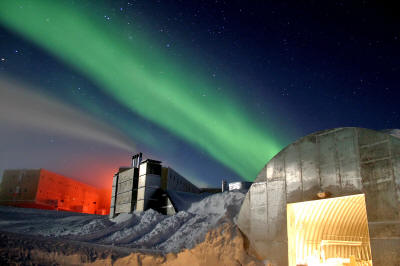
A full moon and 25 second exposure allowed sufficient light into
this photo taken at Amundsen-Scott South Pole Station during the
long Antarctic night.
The new station can be seen at far left, power
plant in the center and the old mechanic's garage in the lower
right.
Red lights are used outside during the winter darkness as
their spectrum does not pollute the sky, allowing scientists to
conduct astrophysical studies without artificial light interference.
There is a background of green light.
This is the Aurora Australis,
which dances thorugh the sky virtually all the time during the long
Antarctic night (winter)
The photo's surreal appearance makes the
station look like a futuristic Mars Station.
(Date of Image: July
2005)
Elevated station (2003 - present)
Construction of a new station, adjacent to the Dome, began in 1999.
Features of the new station included a modular design, to
accommodate an increasing station population, and an adjustable
elevation, in order to prevent the station from being buried in
snow.
The building faces into the wind with a sloping lower portion
of wall. This angled wall increases the speed of the wind as it
passes underneath, causing the snow to be scoured away and keeping
the building from being quickly buried. Wind tunnel tests show that
scouring will continue to occur until the snow level reaches the
second floor.
In a location that receives about 20 cm (8 inches) of snow every
year without ever thawing, the building's rounded corners and edges
help reduce snow drifts. Because snow gradually settles over time
under its own weight, the foundations of the building were designed
to accommodate substantial differential settlements over any one
wing, any one line, or any one column. If differential settlement
continues, the supported structure will need to be jacked and
leveled.
The facility was designed to be jacked up an entire story, so the
primary building columns are outboard of the walls.
During jacking,
a new height of column will be added over the existing columns, and
jacks will pull the building up to the higher elevation.
Operation
During the summer the station population is typically over 200.
Most
personnel leave by the middle of February, leaving several dozen
(127 in 2005) "winter-overs", mostly support staff plus a few
scientists, who keep the station functional through the months of
Antarctic night. The winter personnel are isolated between
mid-February and late October. Wintering-over offers notorious
dangers and stresses, as the station population is almost totally
isolated. The station is completely self-sufficient, and powered by
three generators running on JP-8 jet fuel.
Between October and February, there are several flights per day of
ski-equipped LC-130 Hercules aircraft from McMurdo to supply the
station. Dimensional cargo capacity of the Hercules aircraft must be
considered for all of the station's logistical support. Large
scientific experiments and structures such as the new station are
broken down into modular pieces and reassembled on-site.
Limitations
of the Hercules aircraft have been cited by the National Science
Foundation as one of the main reasons for the proposed development
of an over-ice ground supply route.
Research at the station includes glaciology, geophysics,
meteorology, upper atmosphere physics, astronomy, astrophysics, and
biomedical studies.
Most of the scientists work in low-frequency
astronomy; the low moisture content of the polar air, combined with
the altitude of over 2743 m (9,000 feet), causes the air to be far
more transparent on some frequencies than is typical elsewhere, and
the months of darkness permit sensitive equipment to run constantly.
SOURCE
Mars On Earth -
NASA at the North Pole

Haughton Crater, Nunavut, NWT, Canada
Excerpt
The Haughton-Mars Project (HMP) is an international
interdisciplinary field research project centered on the scientific
study of the Haughton impact structure and surrounding terrain,
Devon Island, High Arctic, viewed as a terrestrial analog for Mars.
The rocky polar desert setting, geologic features and biological
attributes of the site offer unique insights into the possible
evolution of Mars - in particular the history of water and of past
climates on Mars, the effects of impacts on Earth and on other
planets, and the possibilities and limits of life in extreme
environments.
In parallel with its Science program, the HMP supports
an Exploration program aimed at developing new technologies,
strategies, humans factors experience, and field-based operational
know-how key to planning the future exploration of the Moon, Mars
and other planets by robots and humans.
The HMP is managed and operated by the Mars Institute with support
from the SETI Institute.
HMP-2007 is the 11th field season of the HMP.
SOURCE
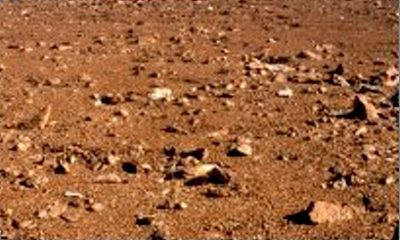
Mars-like rocky polar
desert
of Devon Island
The terrain in the crater and surrounding area bears a remarkable
resemblance to Mars and with the cold temperatures, make this an
ideal place to study systems and human responses in a harsh
environment.
More Information
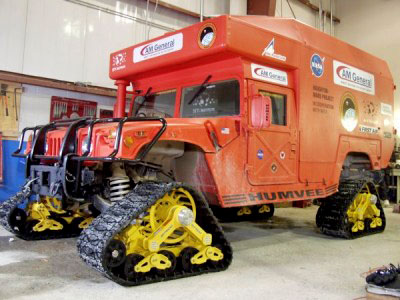
A modified High Mobility Multi-purpose Wheeled Vehicle - or Humvee
for short - has been added to the technological tool kit at the NASA
Haughton-Mars Project (HMP), stationed on Devon Island, Nunavut, in
the Canadian high Arctic.
Tagged the "MARS-1", the Humvee rover is a powerful addition to
scientific studies on Devon.
The vehicle serves as a long-distance
roving field lab. It also doubles as a test bed for studying the
design and operation of future large pressurized rovers for the
human exploration of the
Moon and
Mars.
Mars Institute
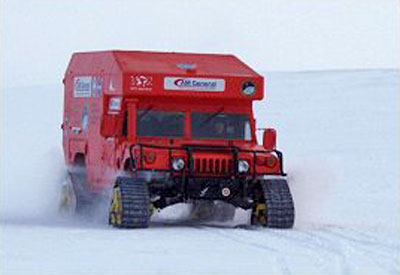
MARS-1 Humvee en
route to Devon Island
from Cornwallis Island, Nunavut, Canada.
Back to Contents
Part 4
The Walt Disney -Werner Von Braun
Collaboration
...and Its Influence on Space Exploration
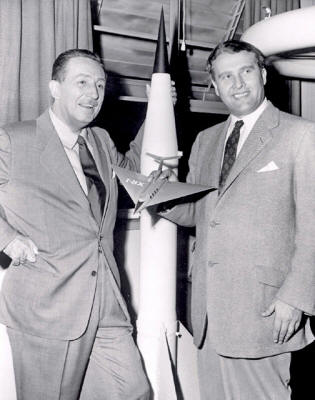
Walt Disney and Dr.
Wernher von Braun
Dr. Werhner von Braun, then Chief, Guided Missile Development
Operation Division at Army Ballistic Missile Agency (ABMA) in
Redstone Arsenal, Alabama, was visited by Walt Disney in 1954.
In
the 1950's, von Braun worked with Disney Studio as a technical
director, making three films about space exploration for television.
A model of the V-2 rocket is in background.
Source
Excerpt
Disney, who would become an international icon, opened Disneyland
the same year that von Braun worked as a technical director on three
Disney TV programs about space.
The first, "Man in Space," aired on ABC on March 9, 1955. The
second, "Man and the Moon," aired the same year, and the final
film, "Mars and Beyond," was televised on Dec. 4, 1957.
Source
Moon Base Shown on Many Websites
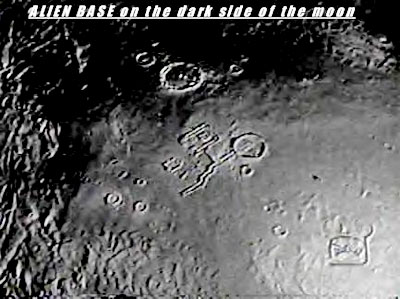
This animation (click above
image) created by XXXXXX, a member of AboveTopSecret.com
Post ID clearly shows that the Moon Base image is in fact a still
from the Disney TV image.
What better way to hide a Moon Base
project than to release a Science Fiction film at the same time...
Testing the Public's Reactions to UFO's
Report
On the weekend of 18th-19th March 1995, the Disney Corporation
conducted a sneak telecast of a UFO documentary without any prior
announcement in five TV viewing areas (Connecticut, Tennessee,
Alabama, Florida and California).
This amazing documentary,
featuring Disney Chief Executive Officer Michael Eisner, put the
reputation of the Disney Corporation behind the documentary's many
startling statements, such as the following:
-
"Mankind is in the midst of the most profound event in history:
actual contact with intelligent life from other planets."
-
"Intelligent life from distant galaxies is now attempting to make
open contact with the human race, and tonight we'll show you the
evidence."
-
"From beyond the boundaries of our perceptions, intelligent beings
are beckoning mankind to join the galactic community. It's an
invitation which is both wondrous and terrifying."
-
"Alien ships seem to arrive in waves, and if the last few years
are any indication, planet Earth is experiencing a tsunami of
sightings."
-
"As early as 1947, the large alien ships began to arrive,
navigated by living creatures. Their advanced physics allowed them
to traverse the galaxy and pierce Earth's atmosphere with amazing
speed."
-
"More than one alien craft crashed and was recovered for secret US
military research."
-
"This is the actual site [Roswell, New Mexico] where
the Roswell
saucer was discovered, along with the bodies of three
extraterrestrial missionaries who didn't survive the collision. The
debris and the dead were impounded and taken away for top-secret
study, while a classified investigative committee, called the
Majestic Twelve, was organized by President Truman, and a government
cover-up was initiated with a calculated disinformation campaign."
-
"For governments determined to maintain their authority,
extraterrestrial contact is pure dynamite."
-
"When [Jimmy Carter] assumed the office of President of the United
States, his staff attempted to explore the availability of official
investigations into alien contact. As this internal government memo
illustrates, there are some security secrets outside the
jurisdiction of the White House."
-
"In November of 1975, essentially every SAC [Strategic Air
Command] base in the United States was visited by UFOs."
-
"Indications are that government, military and scientific leaders
will soon release nearly a half-century of official documentation of
ongoing alien encounters on Earth."
-
"Statistics indicate a greater probability that you'll experience
extraterrestrial contact in the next five years, than the chances
that you will win a state lottery."
-
"Most Americans will likely explore outer space aboard crafts of
alien origin."
Some UFO researchers feel that these 'stealth' Disney documentary
broadcasts were a test of the public's ability to handle the
revelation of UFO reality and the government cover-up.
Source
Exploring Antarctica (1967)
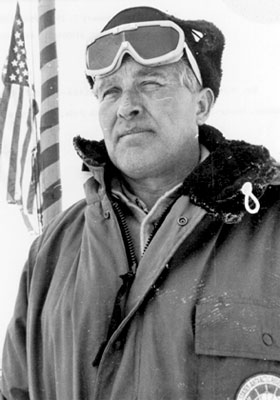
Credit: NASA
Intrigued by exploration in space and on Earth, Dr.
Von Braun
participated in an expedition to Antarctica. This above photo was made on
or about January 7, 1967.
See more about
Wernher von Braun and his Antarctica Expedition.
Disney Works with Lockheed Martin
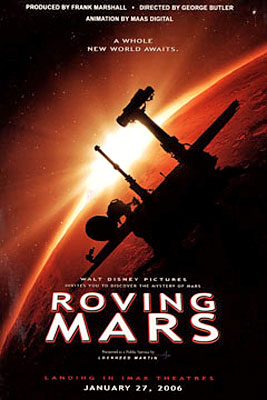
Walt Disney Presents "Roving Mars"
Presented as a Public Service by Lockheed Martin
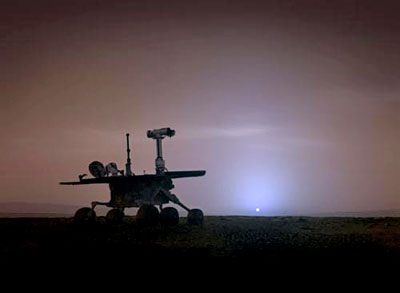
Maas Digital created this dramatic, scientifically accurate computer
animation to illustrate NASA's Mars Exploration Rover mission.
Back to Contents
|












































